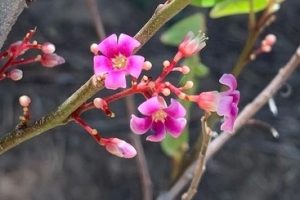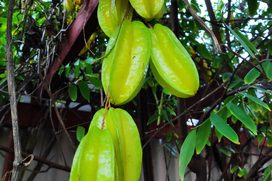Averrhoa carambola
Carambola, star fruit
Origin
There is some contention, but it’s probably native to south east Asia. Now grown in many countries such as the Phillipines, USA, Brazil, Trinidad and Australia.
Climate
It is primarily a lowland tropical species but can grow well in warm sub-tropical climates with mild winters. Well distributed rainfall of 1500-3000mm pa is optimal. However mature plants can withstand some drought periods but yield will be reduced. The ideal temperature range is 21-32°C with growth ceasing below 15°C. Temperatures in excess of 30°C reduce pollen germination and hence yield.
Plant Description
A small, evergreen, slow-growing, symmetrical tree, rarely beyond 8m high. It has very dense lateral and deep roots. Leaves are imparipinnate, bronze when young and pale to dark green when mature, with 2-11 pairs of leaflets.
Relatives
Oxalidaceae Family. The most important close relative is bilimbi.
Soils
Almost any soil is satisfactory if well-drained. A pH of 5.5-6.5 is preferred but it can grow sub-optimally in alkaline soils up to pH 8.
Propagation
Seeds are recalcitrant but will germinate readily if sown fresh. Seedling plants are not true to type and grafting is the main technique for producing reliable traits. Air–layering is problematic.
Cultivars
Cultivars commonly seen in Australia are Arkin, Kary and Fwang Tung.
Flowering and Pollination
Inflorescences occur as compound racemes towards the periphery of the tree, usually from leaf axils but also occasionally from latent buds on older shoots and terminally on new shoots. The small flowers are perfect with pink sepals and a purple corolla. Plants exhibit heterostyly with some having long styles and others short. In the wet tropics flowering is almost continuous, whereas in drier environments a period of water stress acts as an inducer. Despite extensive flowering, fruit set is usually low. Cross-pollination between long and short style types can result in 3-20% fruit set, whereas self or same style type pollination may give only 0.5%. The long style types can be more self-fertile. Bees are attracted to the flower nectar and are the main pollinators, but other insects and wind also contribute.
Cultivation
They do best in full sun and young plants will need frequent watering. Mature plants will require supplemental watering during dry periods. When fruiting commences, regular fertilization will be required, increasing commensurately with tree size. In alkaline soils there may be micronutrient deficiencies which can be addressed by several foliar sprays each year.
Wind Tolerance
Strong wind can result in loss of foliage and damaging fruit rub or loss, but trees may recover. Trees crop best with wind protection.
Pruning
Pruning to the vase shape should be undertaken with young trees to give good light penetration throughout the canopy. Narrow-angled branches should be removed as these are weak and will break under fruit load or other stress. Trees should be maintained at a maximum of 2.5-3m height for ease of harvesting and spraying, Depending on the degree of fruit set, flower and fruit thinning may be necessary to increase fruit size and prevent branches breaking. The tree can also be espaliered.
The Fruit
It is a delicate indehiscent berry with thin waxy skin, 5-10cm long and 3-6cm across, with 5-6 acute ridges running longitudinally. Cross-section slices have a star shape. Skin colour changes from green to yellow-orange when ripe. The yellow flesh is tart/acid to very sweet depending on variety and contains 3-15 small seeds. It has reasonable levels of vitamin C and Brix of 6-18%; ripening results in decreased acidity and increased sugar levels. Oxalic acid content is about half that in spinach and the newer sweeter cvs have even lower levels. Although skin colour may change after picking, the fruit does not ripen further.
Fruit Production and Harvesting
Seedlings may not flower for 4-6 years whereas for grafted plants it may be only 1 year. Fruit harvest is from late summer through to late winter in sub-tropical climates. The home grower should wait till fruit are fully ripe before picking for best flavour. Storage life of fully ripe fruit may be only a few days at room temperature but in a crisper they may last 3-4 weeks.
Fruit Uses
Usually eaten fresh or in salads, but also in processed forms. The acid levels provide reasonable protection to browning when cut. Green fruit are also consumed as a vegetable.
Pests and Diseases
These include fruit flies, moths, mealy bugs, scale and anthracnose in humid environments. Birds can also cause problems.
Comments
Don’t cursorily judge carambola by the sour, prematurely-picked fruit sold by supermarkets. Fully tree-ripened fruit of good, sweet cvs are much better. Well-managed mature trees in ideal climates can be very productive, with yields up to 400kg/tree if not properly and sufficiently thinned. Arkin and Kary are long-styled and more likely to have reasonable self-fertility.
A word of caution: some people may have a bad reaction when they eat carambolas, especially those with renal failure or on dialysis. If they are new to you, try them with caution until you know how you will react.

